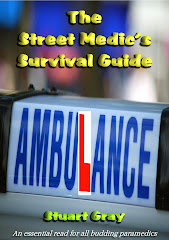Day shift: Four calls; one by car; one assisted-only; one declined; one gone before arrival.
Stats: 1 eTOH; 1 Panic attack; 1Headache.
They put me on a ‘truck’ for the morning to help a trainee who was being assessed. I was his bitch for a few hours as he impressed the Training Officer with his skills and knowledge. We used to call this rideout a ‘Millar’ (or the clinical part of it) and it qualified you as a fully-fledged Ambulance Technician. I left them to it when I had to go to my regular(ish) FRU meeting – I’m sure he will do well.
When I returned from my free lunch and discussions, I was tasked to a one-after-the-other treat of low-grade calls, starting with a 40 year-old female who was ‘almost falling over’ and ‘drunk’ outside a cafe. She had hip problems in fact, and her balance was all over the place because of it but she had a stick to compensate. Yes, she’d had a drink or three as well but she always did, she told me. She wasn’t happy that people had called an ambulance for her but I offered to drive her to her flat because I was sure she wouldn’t get too far down the street before she toppled over. Her home was a few streets away and it wasn’t a problem.
She chatted to me (or at me) all of the way in the car and to the top of her stairs, where her flat, shrouded in dust and debris from ongoing building works, greeted us with open door. The workmen were inside – she’d given them the key.
As soon as I stepped out of the flat (the woman offered me a pair of shoes from the hallway because she thought they’d suit me) I was sent literally across the street to a pub where a 21 year-old Italian tourist had collapsed. Her friends thought she was having an asthma attack but she was panicking. Her bag had been snatched while she sat with the group she was with and now she was upset. Not really a 999 call.
I reassured her and she declined medical help or a trip to hospital – the only sensible choice.
Straight away, I was off to a surveillance store, where a 50 year-old man had called us and the police. He’d stated that he had a headache (thus an ambulance was required)and that the store staff were ‘keeping him in there’. The police were on scene when I arrived but the man, who insisted I took his blood pressure and then promptly asked me to write it down for him, as well as my own details (he got my call sign), was erratic and nervy – he refused to go to hospital, then said he wanted to, then refused again. I asked him over and over if he wanted me to take him but in the end he told us he’d make his own way ‘immediately’ and that was that.
The patient with back pain who’d suffered for a week and now wanted an ambulance got one – me. Unfortunately, even after a week, he had no patience to wait and went up the road to the Walk-in Centre in a taxi. Apparently, according to his colleague who met me when I arrived on scene, he had to be carried.
Be safe.
Subscribe to:
Post Comments (Atom)















4 comments:
Interesting item in Sunday Telegraph today (21 March)- on an "alleged" glitch in call centre software- //It meant that for a decade, 999 calls in which a patient lay unconscious and struggled to breathe after a fall of 6ft or more were “downgraded”, with call handlers told not to send the most urgent response.
Some services told operatives to “override” the flaw, but The Sunday Telegraph has established that five out of 12 of England’s ambulance trusts told call handlers not to diverge from the automated advice.//
http://tinyurl.com/yhm2shk
This used to happen with certain calls in the LAS. The American system we used arranged the calls from echo to omega with numerical suffixes to further divide them. When used in the UK the targets are different. Red, amber, green. And are applied in differing orders to the ones in the U.S. So what would warrant a response there warrants a different response here if it is thought to actually not require as high a response as originally given. As such some times the call handler has to downgrade on the U.S system to upgrade a call on The U.K targets.
Every call taker is told to take the worst case/highest response, but a lot I met either didn't understand or just were not aware.
Interestingly this means RTCs which go amber automatically for high mechanism are normally not upgraded to red when unconscious patients are present.
Luckily in the LAS the control staff are excellent and normally account for this.
Call handlers do not send the resources. Allocators do. This newspaper is reporting half a story, and any allocator worth their salt would send on any dodgy sounding call straight away, regardless of category.
More of a question than a comment...
How do you think the problem of abuse of ambulances should be tackled? I don't mean people mistaking minor symptoms for major ones, but the people who call an ambulance for minor non urgent calls? Like the back ache for a week caller, or the can't reach the remote person?
Personally i'd give the ambulance trusts the power to bill them, get a CCJ ten get an attchment of earnings/benefits and take the money back at source! Hit them where it hurts.
Education is all very well, but the pig ignorant don't listen.
I know that's all very well for me to say from the comfort of my sofa, and with my limited knowledge of emergency medicine. But there has to be smething that can be done.
Minty
Post a Comment